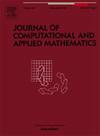A library in CoCoA for implementing railway interlocking systems
IF 2.6
2区 数学
Q1 MATHEMATICS, APPLIED
Journal of Computational and Applied Mathematics
Pub Date : 2025-02-24
DOI:10.1016/j.cam.2025.116594
引用次数: 0
Abstract
In this paper, we propose a user-friendly library in CoCoA to address and completely resolve the challenges posed by the highly efficient and intriguing mathematical model introduced in Hernando et al., (2023) for implementing railway interlocking systems. Although the algebraic model (Hernando et al., 2023) allows for fast performance, it requires implementers and users to have a high level of mathematical knowledge, mastering concepts such as Gröbner bases, ideals, rings, and polynomials. This expertise is necessary to manually define ideals generated by numerous complex polynomials in multiple variables, which depend on the railway station’s topology, a process that can be both tedious and error-prone. To completely resolve these challenges, we have developed a CoCoA library that streamlines the implementation of interlocking systems using our mathematical framework, effectively eliminating manual errors. Consequently, thanks to the library we have developed and presented here, even users without mathematical knowledge can easily implement and manage a railway interlocking system.
用于实现铁路联锁系统的CoCoA库
在本文中,我们在CoCoA中提出了一个用户友好的库,以解决并完全解决Hernando等人(2023)中引入的用于实现铁路联锁系统的高效且有趣的数学模型所带来的挑战。尽管代数模型(Hernando et al., 2023)允许快速性能,但它要求实施者和用户具有高水平的数学知识,掌握Gröbner基、理想、环和多项式等概念。这种专业知识对于手动定义由多个变量中的许多复杂多项式生成的理想是必要的,这取决于火车站的拓扑结构,这一过程既繁琐又容易出错。为了彻底解决这些挑战,我们开发了一个CoCoA库,它使用我们的数学框架简化了联锁系统的实现,有效地消除了人工错误。因此,由于我们在这里开发和展示的库,即使没有数学知识的用户也可以轻松实现和管理铁路联锁系统。
本文章由计算机程序翻译,如有差异,请以英文原文为准。
求助全文
约1分钟内获得全文
求助全文
来源期刊
CiteScore
5.40
自引率
4.20%
发文量
437
审稿时长
3.0 months
期刊介绍:
The Journal of Computational and Applied Mathematics publishes original papers of high scientific value in all areas of computational and applied mathematics. The main interest of the Journal is in papers that describe and analyze new computational techniques for solving scientific or engineering problems. Also the improved analysis, including the effectiveness and applicability, of existing methods and algorithms is of importance. The computational efficiency (e.g. the convergence, stability, accuracy, ...) should be proved and illustrated by nontrivial numerical examples. Papers describing only variants of existing methods, without adding significant new computational properties are not of interest.
The audience consists of: applied mathematicians, numerical analysts, computational scientists and engineers.

 求助内容:
求助内容: 应助结果提醒方式:
应助结果提醒方式:


